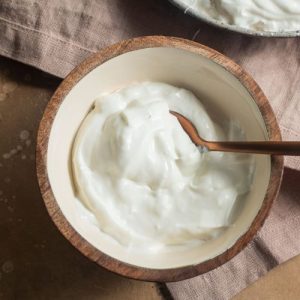
Homemade Greek Yogurt
Whip up thick, creamy Greek yogurt at home using just milk and a small amount of plain yogurt as starter. High in protein and calcium, this versatile yogurt is perfect for breakfasts, snacks, or meal prep. Strain for extra thickness and enjoy it plain, with fruit, or in your favorite recipes.
Equipment
- 1 large heavy-bottomed pot or Dutch oven
- 1 fine-mesh sieve
- 1 Large cheesecloth
- 1 Cooking thermometer or candy thermometer
- 1 Large glass or stainless steel bowl with lid
Ingredients
- 0.5 gallon whole milk
- 0.25 cup plain yogurt with live active cultures
Instructions
- Sanitize Equipment for Safety: Before touching any ingredients, ensure that all your utensils, bowls, pots, and thermometers are meticulously clean. Bacteria can interfere with the yogurt fermentation process, so wash everything with hot water and mild soap, then rinse thoroughly. You may also briefly immerse metal tools in boiling water to further sterilize. Using clean equipment ensures your yogurt turns out fresh, safe, and tangy.
- Gently Heat the Milk: Pour ½ gallon of whole milk into a heavy-bottomed pot or Dutch oven. Place over low to medium-low heat and slowly warm the milk to 180°F (82°C). Stir frequently with a long-handled spoon or spatula to prevent scorching or forming a skin on the surface. Heating the milk to this temperature helps denature proteins, which is essential for a thick, creamy yogurt texture. This step usually takes 15–20 minutes.
- Cool Milk to Incubation Temperature: Once the milk reaches 180°F, remove the pot from heat. Allow it to cool gradually to about 108°F (42°C), the ideal temperature for yogurt cultures to grow. Stir occasionally to help the heat dissipate evenly. To speed cooling, place the pot in a larger bowl filled with ice water, ensuring the pot does not sit directly in the water. Patience here ensures that the yogurt cultures remain active and unharmed.
- Prepare the Yogurt Starter: In a small bowl, mix ¼ cup of plain yogurt with ¼ cup of the cooled milk. Whisk until the mixture is completely smooth with no lumps. This step “tempers” the yogurt, preventing shock to the live cultures when added to the larger batch of milk. It helps create a consistent and creamy final yogurt.
- Combine Starter and Milk: Pour the tempered yogurt mixture into the cooled milk and gently whisk until thoroughly blended. Make sure the starter is evenly distributed throughout the milk, which ensures uniform fermentation and a smooth texture. Avoid vigorous stirring that might introduce air bubbles.
- Incubate the Yogurt: Transfer the milk-and-yogurt mixture into a clean glass or stainless steel bowl. Cover the bowl with a lid or clean kitchen towel. Place the bowl in a warm environment, ideally around 100°F (37°C). A convenient method is to use the oven with only the light turned on, or a ‘proofing’ setting if your oven has one. Let the yogurt sit undisturbed for 16–24 hours. During this time, the live cultures ferment the milk, thickening it and developing a tangy flavor. The longer it incubates, the firmer and more tart the yogurt will become.
- Check Yogurt Consistency: After the incubation period, check the yogurt’s texture. Gently tilt the bowl the yogurt should hold its shape and appear jelly-like, without being runny. If it still seems loose, allow it to incubate a few more hours. This step ensures that your yogurt achieves the ideal thickness and creamy consistency.
- Chill the Yogurt (Optional: Enjoy Soft Yogurt): At this point, you can transfer the yogurt to the refrigerator and enjoy it as a soft, creamy yogurt. Cooling the yogurt helps it firm up slightly and enhances the flavor. This version is ready to eat immediately or use in recipes requiring plain yogurt.
- Strain for Thick Greek Yogurt: For traditional Greek-style yogurt, place a fine mesh strainer over a large bowl and line it with a large cheesecloth. Carefully scoop the yogurt into the lined strainer. Cover and refrigerate for 5–8 hours, or until it reaches your desired thickness. The liquid that drains out is whey, which can be saved for smoothies, baking, or soups. Straining concentrates the protein and creates a rich, velvety texture.
- Store and Serve: Transfer the thickened Greek yogurt into a clean, airtight container and chill completely in the refrigerator. Properly stored, it keeps for 1–2 weeks. Enjoy it plain, sweetened lightly with honey, topped with fresh fruit, or used in dips, dressings, and savory recipes. The homemade yogurt is versatile, protein-packed, and a wholesome addition to daily meals.
Notes
- Always use whole milk for the creamiest results; lower-fat milk can yield thinner yogurt.
- Choose plain yogurt with live active cultures as your starter to ensure proper fermentation.
- Straining yogurt is optional but recommended for thick Greek-style consistency; the leftover whey can be used in smoothies, baking, or soups.
- Temperature control is key: incubating too hot or too cold can affect texture and tanginess.
- Flavor variations can be added after chilling, such as honey, fruit, or vanilla extract, but avoid adding sweeteners before fermentation.